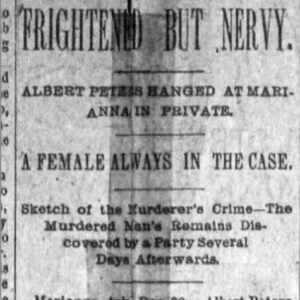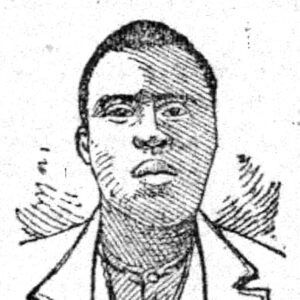calsfoundation@cals.org
Albert Peters (Execution of)
Albert Peters was a young African American man hanged on December 30, 1887, at Marianna (Lee County) for murdering the husband of his “paramour.”
Albert Peters was born into slavery at the Dr. G. B. Peters Plantation near Council Bend in Lee County on October 10, 1860. His family moved to Memphis, Tennessee, after the Civil War, and then to Phillips County, where he attended Southland College. Peters was later described as “very black, medium hight [sic] and weight, clean shaven face and had a tolerable fair education, being able to read very well and write a respectable hand.”
By 1885, he was once again living on the Peters plantation but, early that year, went to Phillips County, “where he ingratiated himself into the good graces of the wife” of William (sometimes referred as Sam) Johnson, a man who may be the twenty-four-year-old laborer the 1880 census shows living at Spring Creek (Phillips County). Peters convinced the wife (whose name was unrecorded in accounts) to return to Walnut Bend with him, but Johnson followed, arriving there around April 1, 1885, and convincing her to come home.
On April 5, 1885, Peters killed Johnson. An article written not long after the incident reported that Peters “waylaid him…knocked him in the head with a club, cut his throat, carried the corpse to the woods and buried him,” but evidence at his trial showed that he initially swung an axe, which Johnson blocked with clothing he was carrying, and then chased him “for a mile and a half, Johnson crying, Albert, don’t kill me.” Johnson’s “mutilated” body was found a few days later, and Peters, who had used Johnson’s coat as collateral to get a watch out of a pawn shop, was arrested.
Peters escaped the Lee County jail on June 19, 1885, after picking the lock of his cell and telling a fellow prisoner “he would not be brought back alive.” He was captured four days later near Helena (Phillips County). Peters again escaped on October 19, 1885, this time fleeing to Texas before again being captured at Rosedale, Mississippi, on May 15, 1887.
Peters was tried on October 28, 1887, and the Lee County jury was “out but a few minutes” before returning with a verdict of guilty of first-degree murder and a death sentence. Efforts to have Governor Simon P. Hughes commute the sentence failed, and his hanging was set for December 30, 1887.
Unlike many executions that had crowds of thousands, Peters’s hanging was conducted in a “private” space with only twenty-five to thirty witnesses. A Memphis newspaper wrote that “Peters was very religious and resigned, frightened but nervy” as he mounted the gallows, while the Arkansas Gazette reported that “he appeared merry, but very much frightened and visibly affected on the scaffold.” The trap door was sprung at 11:00 a.m., and “the body dropped seven feet with a jerk which broke the condemned man’s neck. There was but a slight twitching of the muscles and all was still.” He was declared dead twelve minutes later.
For additional information:
“Arkansas.” [New Orleans, Louisiana] Times-Picayune, May 17, 1887, p. 4.
“Frightened But Nervy.” Memphis [Tennessee] Avalanche, December 31, 1887, p. 1.
“Hangman’s Day.” St. Louis [Missouri] Globe-Democrat, December 31, 1887, p. 3.
“Helena, Ark.” Memphis [Tennessee] Avalanche, June 25, 1885, p. 1.
“Helena, Ark.” Memphis [Tennessee] Daily Appeal, May 5, 1885, p. 1.
“A Jail Breaker.” Memphis Avalanche, June 21, 1885, p. 1.
“Jail-Birds at Large.” Arkansas Gazette, October 21, 1885, p. 1.
“Our Specials.” Arkansas Gazette, December 31, 1887, p. 1.
“To Pay the Death Penalty.” Memphis Avalanche, October 29, 1887, p. 4.
Mark K. Christ
Central Arkansas Library System
 Law
Law Post-Reconstruction through the Gilded Age, 1875 through 1900
Post-Reconstruction through the Gilded Age, 1875 through 1900 Albert Peters Execution Story
Albert Peters Execution Story  Albert Peters Execution Story
Albert Peters Execution Story  Albert Peters Portrait
Albert Peters Portrait 




Comments
No comments on this entry yet.